A new inspection of the fatal section near Telish, where 12-year-old Siyana died in an accident. Investigative experiments are being carried out on the Radomirtsi - Telish section. Investigators took cores from the road surface, BNT reports.
These are samples that will examine how high-quality and thick the asphalt and asphalt coating were before the accident.
The team of the European Center for Transport Policies also arrived at the scene.
From their findings, it became clear that what the Road Agency wrote that the road was in good operating condition is not justified.
What is noticeable at first glance is that in places the ruts that have formed in the 20-year-old asphalt from the trucks are so deep that water cannot pass easily to the shoulder and from there to the ditches, which creates a risk of aquaplaning.
In places, the signs are more than 10 years old. The regulation requires that they be replaced after 10 years.
The markings also do not meet the requirements. It is confirmed and is currently one of the leading versions that the patches on the road are one of the main reasons for this serious accident.
"This is a road with many problems. Ruts have formed with a depth of almost 10 centimeters in places. This is a prerequisite for water retention. The second problem - road signs that are over 10 years old. The third problem - the lack of light reflectivity of the markings. The fourth - the earth slopes, which are grassed and the water cannot go into the ditches, which is a very significant problem," said Diana Rusinova, chairwoman of the European Center for Transport Policies.
Investigative actions are continuing and it is not clear how long the road will remain closed. Traffic to the capital is being redirected via bypass routes.
